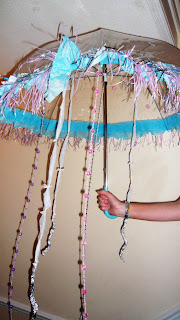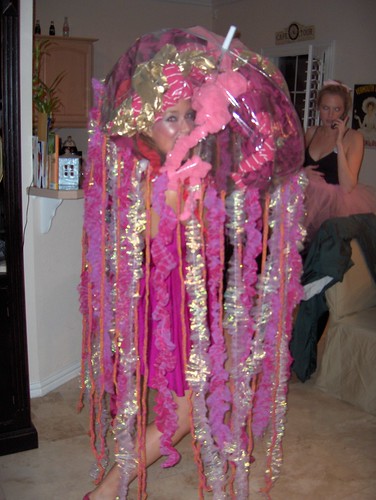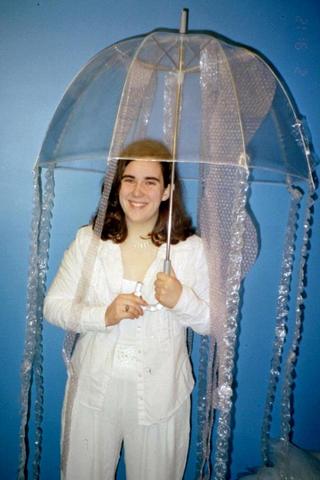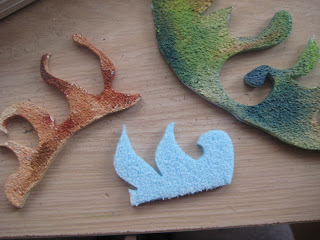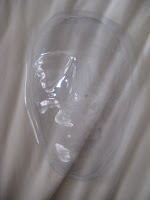Today I spent the whole day working on my prototype so that it would be ready for the design presentation and group discussion with Sarah Colwell and Jo Gardener.
I bought a seethrough type umbrella from Pound Land; one very similar to those I found were used alot in my research. I also bought some cheap strings of beads, shreaded tissues paper, sheets of tissue paper, strings of sequins and glitter paint.
I tried not to make it too complcated and to just go with it!
One thing I noticed was PVA glue was not strong enough to hold on some of the sequins at the top section and after a while they would fall off. Also some of the sequin strip would need alot of glue to hold it on. I know that in the past glue guns have been used to attach decoration so I will make sure I have some of these in the classroom so that any heavy beads or sequins can be attached securely.
Also the shreaded tissue paper was very fiddly to attach and I think that the metalic ribbon that I have mentioned in my post previously would be a much quicker and simple way to add some detail around the umbrella/ tenticles.
Wednesday, 30 March 2011
Tuesday, 29 March 2011
Jellyfish Costume
These are some images of how the umbrella Jellyfish Costume has been made by other people in the past. This has helped me think of other materials to use that would be easy to source and not too expensive. The seethrough umbrella seems to be the most common choice as it reflects the translucent nature of the Jellyfish itself.
Bubble wrap is a really cheap material to use and it can also be dyed any colour and it still keeps its translutent effect. It also takes paint really well and the bubbles create a cool texture like tenticles.
Another idea is to use the thin ribbon that is commonly used for adding detail to wrapped gifts. This would be really cheap and the shiney effect would look brilliant to add some glitz to the cotumes. Its also really easy to curl with a pair of sissors which I would of course supervise the children to do themselves or if need be I could do this myself at the end of the class. These long stripes of curly ribbon would look really effective as tenticles on both the t-shirts and the umbrellas.
Bubble wrap is a really cheap material to use and it can also be dyed any colour and it still keeps its translutent effect. It also takes paint really well and the bubbles create a cool texture like tenticles.
Another idea is to use the thin ribbon that is commonly used for adding detail to wrapped gifts. This would be really cheap and the shiney effect would look brilliant to add some glitz to the cotumes. Its also really easy to curl with a pair of sissors which I would of course supervise the children to do themselves or if need be I could do this myself at the end of the class. These long stripes of curly ribbon would look really effective as tenticles on both the t-shirts and the umbrellas.
Monday, 21 March 2011
Lyme Regis Trip
Today myself and Grace made a trip to Lyme Regis. As soon as we had arrived we had our cameras out taking photos of not just relevent info for this prodject but the whole town itself.
The little windy roads and quaint shops distracted us for a while but we soon got onto finidng the Jurassic Dinosaur and Fossil Museum for Grace. Although I have not chosen to study this topic I still found it really intresting looking at all the marine life past and present and how they have fossilised over time.
Lyme Regis is abundant of fossil life and there are many organised trips where you can go to collect fossils in a certain part of the coastline.


Lyme Regis is abundant of fossil life and there are many organised trips where you can go to collect fossils in a certain part of the coastline.


Tuesday, 15 March 2011
Trip to Weymouth
Today we made a trip to Weymouth College to have a look at some of the carnival costumes made by or for the children in previous years.
It was really fun to dress and and see what had been done in the past but also scary as some of our ideas had already been used. In my case the Jellyfish Idea I had drawn up in my sketchbook had been created using umbrellas and the tie dye t-shirts. I was at first a bit heart broken but after talking with the regonal artistic director he told me that the Umbrells Jellyfish costumes had never been used due to the carnival being cancelled and that I could incorporate them into my class costumes!
It was really fun to dress and and see what had been done in the past but also scary as some of our ideas had already been used. In my case the Jellyfish Idea I had drawn up in my sketchbook had been created using umbrellas and the tie dye t-shirts. I was at first a bit heart broken but after talking with the regonal artistic director he told me that the Umbrells Jellyfish costumes had never been used due to the carnival being cancelled and that I could incorporate them into my class costumes!
Monday, 14 March 2011
Willow Workshop
Today we had a workshop with a 3rd year student on how we could create a structure using willow and masking tape to secure. It was a really interesting workshop for me as I am hoping to work on a main carnival costume my self when not teaching in the school in Weymouth. I want to make it a larger center piece for the children to carry as well as wearing thier individual costumes.
Sarah cleared up a few points for me:
1. I originally said that I could create an octopus shape and have a horizontal bar at the base for the children to hold up but she pointed out that from her previous experience holding something that large up for a long period of time will be very uncomfortable and as they will be so young they may loose interest or struggle so we decided long poles would be better as they could be carried at waist height and is alot more comfortable.
2. That making such a large sructure I would have to bare in mind transporting it to Weymouth and being able to fit it through doors so maybe to make the body shape and all the legs seperately and fix it all together in Weymouth. After more thought I came up with the idea of attaching the willow tenticle structures onto the main body with purely fabric so that they can be moved around by the children holding them up with the same pole structure as the body.
Here are some photos of experimentation and learning how to create a sphere in willow.
Here I was trying to get the rough shape that an octopus body would be but I found it was harder to do than I thought.
A couple of covering tips Sarah gave us were:
Sarah cleared up a few points for me:
1. I originally said that I could create an octopus shape and have a horizontal bar at the base for the children to hold up but she pointed out that from her previous experience holding something that large up for a long period of time will be very uncomfortable and as they will be so young they may loose interest or struggle so we decided long poles would be better as they could be carried at waist height and is alot more comfortable.
2. That making such a large sructure I would have to bare in mind transporting it to Weymouth and being able to fit it through doors so maybe to make the body shape and all the legs seperately and fix it all together in Weymouth. After more thought I came up with the idea of attaching the willow tenticle structures onto the main body with purely fabric so that they can be moved around by the children holding them up with the same pole structure as the body.
Here are some photos of experimentation and learning how to create a sphere in willow.
Here I was trying to get the rough shape that an octopus body would be but I found it was harder to do than I thought.
A couple of covering tips Sarah gave us were:
- Cover the frame in cling film if you want to give the structure a thick covering because this will stop the wet fabric or tissue paper slumping down or ripping.
- The structures can be covered in fabric pieces dipped in pva glue and water or hand made paper or a strong version of tissue paper. This we were told is very good for a structure that might have light shon from the inside as it has a translucent effect.
Bournemouth Beach Trip
I took a walk down Bournemouth beach and came across some cliffs and rocky structures that really caught my eye. I am very much leaning towards the topic of local sea life and the jurassic coast and I want not not only incorperate the sea animals in my designs but the plant life and rock formations as well. As if to paint a picture of the local coastline itself and not just what can be found under water.
These photos really got my juices flowing with the natural colours and patterns that could be found on the coast. I would really like to incorporate the idea of sea weed into some of my head dresses and flags and I found a video showing the effect marbling creates.
This could be a really effective technique to dye plain white fabric and to create the same muliti tones you find in seaweed. I could also use this technique to create some sort of jelly fish costume as the are a range of species found along the SW coast.
These photos really got my juices flowing with the natural colours and patterns that could be found on the coast. I would really like to incorporate the idea of sea weed into some of my head dresses and flags and I found a video showing the effect marbling creates.
This could be a really effective technique to dye plain white fabric and to create the same muliti tones you find in seaweed. I could also use this technique to create some sort of jelly fish costume as the are a range of species found along the SW coast.
Sunday, 13 March 2011
Vac Forming and Plasterzote Workshop.
We have had a session in the workshop playing around with vac forming and cutting blue foam with a hot wire. This image below is some shapes I cut out and experiemented with paint to make them look like seaweed. I am considering creating a seaweed headress and this would be easy to shape and light to wear but may be too light in the harsh winds by the coast so would need some sort of strap to hold it on.
I have found this session very helpful as it gave me ideas on how to relalise some of the intial ideas I have. These techniques are practical ways of creating a carnival costume that I would have never thought of before, the materials used are lightweight and would be comfortable to wear.
These are some photographs of various materials vac formed over a mold of a face. This plasterzote form above is perfect for masks as it is soft against the skin and takes decoration (paint, glitter, sequins etc) well.
The clear and black plastic materials are not so practical as it would be uncomfortable to have the raw edge againt any skin and once VAC formed it is not very felxible to work with so the children would find it hard to cut as well as potetially dangerous.
Saturday, 12 March 2011
Initial Ideas
I have been doing some research into all of the topics given to us in the briefing. These are a couple of initial ideas that came to mind whilst putting together research pages in my sketchbook.
I really like the topic Marine life that is indigenous to the area - specifically the Jurassic Coast because I feel like there is alot that can be done with local marine life. Alot of carnivals that are based on sealife concentrate on tropical fish, huge sea turtles etc but I think it will be really intresting to base my costumes on local marine life.
I really like the topic Marine life that is indigenous to the area - specifically the Jurassic Coast because I feel like there is alot that can be done with local marine life. Alot of carnivals that are based on sealife concentrate on tropical fish, huge sea turtles etc but I think it will be really intresting to base my costumes on local marine life.
Monday, 7 March 2011
Initial Thoughts
Today I had the first tutorial with Adele and the majority of the Spirit of the Sea group. We discussed various admin subjects like the schedule, any questions regarding budget, transport for the work placement etc which I found very helpful as I had a lot of questions that I wanted to clear up. We also clarified what we were aiming towards at the end of the prodject so that I will be able to start my research and development knowing I was heading down the right path.
Adele confirmed that we will not necessarily hand in a complete carnival costume but instead we will be handing in (in our own choice of medium) an 'idea' of our concept within one of the 7 sections , designs, any sample of experimentation or prototyping and maybe some sections of the costumes being made by the children during the work placements. This is not to say that I could not aim to create masks and tabards with the children but make a larger centre piece in the time I am not in Weymouth by myself.
I took alot from this initial meeting and it cancelled out and also fueled some of the very first ideas I had thought of. I will be able to narrow down and confirm the body of work I will be handing in once my learning agreement is complete. Also, through mood boards and brain storming each of the 7 topics, I hope to make a decision on the theme for my section of the carnival.
Me and Grace are planning a trip to the Marine Aquarium in Lyme Regis as it specialises in local marine life and the Jurassic Coast which is one of the 7 topics. This may help me decide if this topic is the right one for me but will devlop my ideas throughout all of the topics.
http://www.lymeregismarineaquarium.co.uk/ This is there website.
Adele confirmed that we will not necessarily hand in a complete carnival costume but instead we will be handing in (in our own choice of medium) an 'idea' of our concept within one of the 7 sections , designs, any sample of experimentation or prototyping and maybe some sections of the costumes being made by the children during the work placements. This is not to say that I could not aim to create masks and tabards with the children but make a larger centre piece in the time I am not in Weymouth by myself.
I took alot from this initial meeting and it cancelled out and also fueled some of the very first ideas I had thought of. I will be able to narrow down and confirm the body of work I will be handing in once my learning agreement is complete. Also, through mood boards and brain storming each of the 7 topics, I hope to make a decision on the theme for my section of the carnival.
Me and Grace are planning a trip to the Marine Aquarium in Lyme Regis as it specialises in local marine life and the Jurassic Coast which is one of the 7 topics. This may help me decide if this topic is the right one for me but will devlop my ideas throughout all of the topics.
http://www.lymeregismarineaquarium.co.uk/ This is there website.
Subscribe to:
Comments (Atom)

